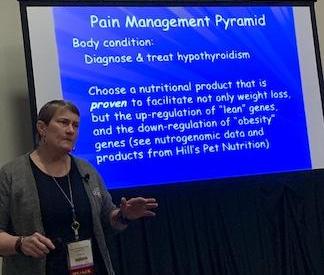Fetch 2018: Multimodal Management of Chronic Pain
Chronic pain is best addressed by targeting multiple areas of pain perception throughout the body and incorporating multiple modalities.
According to Robin Downing, DVM, MS, DAAPM, DACVSMR, CVPP, CCRP, appropriate management of chronic maladaptive pain requires a multimodal approach. In a lecture sponsored by PRN Pharmacal at the 2018 Fetch conference in San Diego, Dr. Downing, who owns 2 practices in Windsor, Colorado, described a comprehensive approach to pain management.

Dr. Downing described the 3 components of pain:
- Sensory: the physiologic pain sensation; the informational component
- Emotional: the suffering aspect of the pain experience
- Cognitive: the memory of a pain experience; the evaluative component
The cognitive component, she said, is relatively unrecognized in veterinary medicine, yet results of human studies have shown that a significant pain experience influences all subsequent pain experiences an individual has.
“What is for sure is that acute pain that is left untreated will lead to chronic maladaptive pain,” she said. Not addressing pain in our patients can lead to detrimental physiologic effects, including death.
Multimodal Pain Management
Multimodal pain management can be likened to a wheel, Dr. Downing suggested, with the patient as the hub of the wheel and the treatment modalities the spokes. “A multimodal approach is appropriate for every single patient,” she said.
Because excess weight gain contributes to the pain experience, the most important physiotherapy technique for pain management is normalization of body composition, which should include a nutritional product that will help animals burn fat and sustain muscle.
Pharmacologic Treatments
All nonsteroidal anti-inflammatory drugs (NSAIDs) have similar safety and adverse effect profiles, Dr. Downing said, noting that failure of one NSAID doesn’t necessarily mean all will fail. “If one is not effective, try a second,” she advised. “But If the second type doesn’t work, then try something else altogether.”
Once pain is controlled with an NSAID, the dose can be titrated or the medication stopped altogether, but that can only be done if a multimodal plan is in place. NSAIDs can be used for a short period of time in animals with liver or kidney disease without fear of disease exacerbation.
Gabapentin, which targets the a-2-d ligand of the calcium channel, must be dosed appropriately, Dr. Downing said. Although activity starts within 12 hours, sustained activity takes about a week. Begin with a dose of 5 to 10 mg/kg 2 to 3 times per day, with the dose escalated to effect. If sedation persists, she said, reduce the dose but don’t eliminate the drug.
Clients should be warned not to discontinue gabapentin abruptly because rebound pain is a real problem, according to Dr. Downing. Drug accumulation in the liver or kidney is uncommon in pets.
Amantadine is an NMDA receptor antagonist that works on a different spot on the dorsal horn. The drug complements NSAIDs and gabapentin and is well tolerated long term. Dosing is 2 to 5 mg/kg/day.
Polysulfated glycosaminoglycans (PSGAGs) are safe to use in both dogs and cats. The product should be given subcutaneously rather than in muscle (this use is extralabel). PSGAGs don’t replace lost cartilage but rather have an indirect anti-inflammatory effect. They should be dosed at 2 mg/lb twice a week for 4 weeks, then once weekly for 4 weeks, and then every 10 to 15 days, depending on the patient’s response. Clients must be taught how to give the drug subcutaneously. Long-term use is fine.
Nonpharmacologic Treatments
Nondrug treatments used to break the pain cycle include:
- Nutrition: Hill’s Prescription Diet j/d has the most data behind it.
- Nutraceuticals: Glucosamine, low-molecular-weight chondroitin, and avocado soybean unsaponifiables (ASU) work better together than on their own; there is no evidence that glucosamine on its own is effective.
- Omega-3 fatty acids: Use glyceride forms that are bioavailable and dose appropriate.
- MicroLactin: A milk protein from hyperimmunized cows with anti-inflammatory properties that works by a different pathway than steroids and NSAIDs.
- Cannabidiol: Targets the cannabinoid receptors in the brain.
Physical medicine should also be part of therapy for painful pets. “There is lots we can do in practice without being trained as a physical therapist,” Dr. Downing said. Multiple resources are available on techniques such as hot and cold therapy, therapeutic ultrasound, hydrotherapy, acupuncture, and more.
“We don’t pay enough attention to assistive devices,” Dr. Downing said, “but slings, wheelchairs, rolling carts, and other devices can really do a lot of good.” Also, modify the environment as needed by moving food and water dishes to an ideal height, covering slippery floor surfaces, adding baby gates, and modifying access to stairs. In addition, advise clients to modify play as needed.